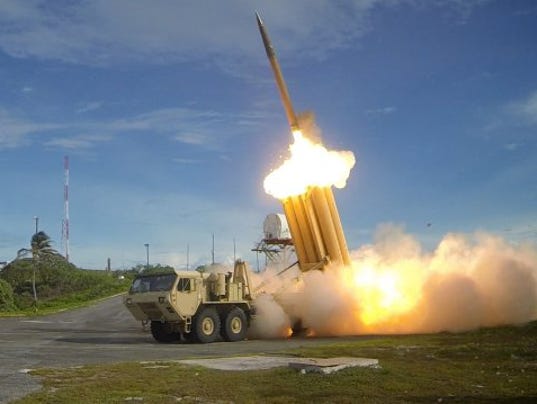BLACKEAGLE
SENIOR MEMBER

The US conducts tests of THAAD interceptors and a Standard-Missile 3 Block IA missile in 2013.(Photo: Missile Defense Agency)
WASHINGTON — In the worst nightmares of the US military's missileers, a foreign foe hits the homeland with a complex barrage of ballistic and cruise missiles, armed UAVs, decoys and electronic attacks, forcing the nation's stove-piped missile defense systems into a dizzying game of whack-a-mole.
To give the US Army a single mix-and-match battle command system for its disparate sensors, launchers and missiles, it is developing the Integrated Air and Missile Defense Battle Command System (IBCS). Like a missile defense dashboard, IBCS would one day control existing interceptor, missile and artillery systems along with futuristic laser, microwave and electromagnetic pulse weapons still in development, officials say.
"We will never have enough interceptors in our quiver, and that's why I would say we need to add a level of sophistication to the way we look at the threat," said Army Lt. Gen. David Mann, commander of Space and Missile Defense Command/Army Forces Strategic Command (SMDC/ARSTRAT). "It needs to be more than just a metal on metal application."
Space and Missile Defense Command's R&D efforts include the High Energy Laser Mobile Demonstrator program, designed to defeat short-range aerial threats, like rockets, mortars and one day, perhaps, missiles. In 2013, it destroyed mortars and UAVs, and now efforts are focused on upgrading its power from 10 kilowatts to 50 or 100 kilowatts.
The command has successfully tested an electromagnetic pulse weapon with a 20-kilometer range to defeat roadside bombs, Mann said, adding that preliminary tests against UAVs have been, "very, very promising."
"It's not a question of if, but when we leverage laser, microwave and directed energy technologies," Mann said. "We cannot afford to launch million-dollar interceptors against thousand-dollar rockets. The price curve is just not with us on that one."
Mann and other officials discussed IBCS at an Association of the US Army missile defense forum here on Thursday.
In 2010, a Northrop Grumman-led team of companies won a $577 million Army contract to kick off IBCS, meant to integrate the Patriot, the Surface-Launched Advanced Medium Range Air-to-Air Missile, Joint Land Attack Cruise Missile Defense Elevated Netted Sensor, Improved Sentinel radar, and the Terminal High Altitude Area Defense and Medium Extended Air Defense System.
Aiming for initial operating capability in 2018, a series of system integration tests for Patriot and Sentinel sensors and launchers are underway at White Sands Missile Defense Range, New Mexico. Developmental flight tests are due for later this year, according to Barry Pike, of Program Executive Office Missile and Space.
Officials say IBCS' modular open architecture falls in line with the Pentagon's Better Buying Power 3.0 affordability efforts, embracing incremental upgrades over expensive system-wide overhauls, offering industry more competitive opportunities in the bargain.
The Army expects to be able to modernize components of IBCS as they are outpaced by enemy threats, and first integrate existing technologies using a "network adaptive kit," Pike said. The Air Force's three dimensional expeditionary long-range radar and other developing technologies would be built to plug into IBCS.
As the Army artillery and missile defense community's top acquisitions priority, IBCS promises the US the ability to untether its sensors, radars and launchers from individual systems so they can be deployed where needed. In turn, it would pull in data from a variety of sensors across the services.
"It breaks us away from our current inflexible, stove-piped [command and control] systems that must be deployed as a whole," said Brig. Gen. Christopher Spillman, commandant of the US Army Air Defense Artillery School.
The Army must not only integrate all of its systems, but connect with the command-and-control, battle management and communications system, which belongs to the Missile Defense Agency, and the Navy's sensor net, the Cooperative Engagement Capability, according to Mann.
Merging assets and territory across the services can be a thorny business, and officials say talks are ongoing about how to do so, and how to one day hand off sensor information to the best possible shooter. Maj. Gen. Ole Knudson, program executive for the Missile Defense Agency, offered a cautious assessment of the effort, which involves talking through requirements and with the Joint Integrated Air and Missile Defense Organization.
"It probably isn't all at once, to evolve this into the force over time," he said. "What you have are three systems from the services that are not inherently compatible. In some ways it's akin to what the Army is doing with several different command-and-control systems, bringing them into IBCS. It is not a simple thing to do."
Whether IBCS would be open to foreign allies, and what the cybersecurity requirements would be, are in debate at the Pentagon, according to Daniel Verwiel, Northrop's lead for air and missile defense. On the one hand, adding foreign assets would relieve stress on Army air and missile defense, on the other, greater openness may leave the network vulnerable to intrusions.
"We know we can take indigenous sensors, indigenous shooters and plug them into the network and they will function, just like they will in the United States," Verwiel said. "Do we want to have a Chinese-made launcher sitting on a US product, do we want a Russia-made capability integrated into that product?"
On the technical side, Northrop Grumman and the Army have worked over the last few years to revise and simplify the original requirements for the common architecture. Now, as systems come together, Northrop is tackling bandwidth and cybersecurity issues that come with networking a crucial command-and-control system.
"We are on the precipice of a great deal of success, doing exactly what we want it to do," Verwiel said. "This year, we have several flight tests demonstrating exactly what this program is capable of doing."
US Army Developing Missile Defense Dashboard
